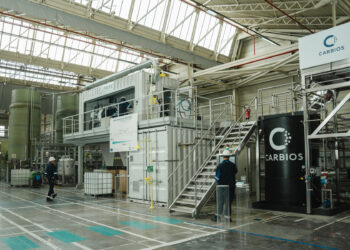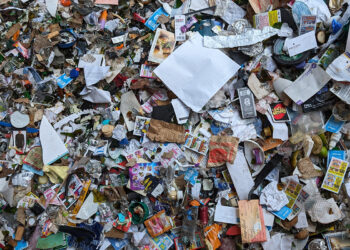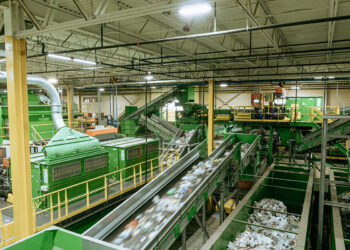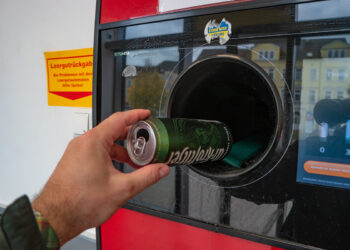This article originally appeared in the August 2018 issue of Resource Recycling. Subscribe today for access to all print content.
The issue of recycling quality did not originate with China’s Green Fence or its recent embargo – recycled materials have been looking more and more like trash for quite some time, and U.S. mills have been complaining for years.
But China’s actions are forcing us to recognize like never before there are truly broken elements of the U.S. system. Materials recovery facilities can technically produce quality materials out of both dual-stream and single-stream inputs, but what can we do to get these cleaner materials? And what can we do to ensure longer-term success?
The time has come to map out a realistic plan to solve contamination. Such a proposal would need to work for all stakeholders involved, but it also must adhere to economic principles.
What’s been attempted thus far
When it comes to generating cleaner material, starting at the curb, a number of approaches have been tried, with varying degrees of success.
Here’s what’s been tried and proven to be unsuccessful:
Clinging to dual-stream. This horse seems out of the barn. Households want single-stream convenience, and with it, they’ve shown they’ll recycle more. With dual-stream, there are many trade-offs that can be debated, but the most important overarching points about the option are the following: collection is more expensive, we get fewer tons in the recycling bin, and we also likely receive pushback from households. There are examples of MRFs that were recently built for dual-stream collection in order to keep materials clean. In at least one case, three haulers operating nearby opted to instead bring their materials more than 50 miles to a single-stream MRF because the haulers found their customers strongly preferred single-stream collection. The dual-stream facility remains dramatically under-capacity.
Voluntary standards and agreements. Voluntary agreements or collaboratives have been tried in some jurisdictions. In one locale, quality standards were established and stakeholders made voluntary pledges to hit them. In another, a region worked to develop a uniform recycling program so education could be more consistent and the MRFs could be optimized for that material mix. These voluntary agreements have not spread and can be severely undermined when just one stakeholder deviates for economic or corporate reasons. Very few of these have been widely touted or emulated.
Meanwhile, other initiatives have found some success, but often come with problematic caveats:
Remove materials. Prohibiting glass or certain plastics from bins and carts is an option communities are considering. However, the downside on glass in particular is a loss of tons, loss of a recyclable product, more energy spent making glass products down the line, and pushback from residents. Also, MRFs can in fact clean and market glass if the right conditions are in place.
Split destinations for glass. Instead of banning glass, programs could rethink strategies for handling the material. One community, for example, decided to expand the glass bunkers at the local convenient drop-offs and then they educated customers by saying they could put their glass in the curbside single-stream but that a much higher percentage of the glass going to the bunkers actually got to recycling markets. That kept their tons up (everyone could still recycle at the curb if they wanted), but it substantially reduced glass tons going through the MRF (see a feature in the November 2011 edition of Resource Recycling for a full discussion of this case study). It’s important to keep in mind that this strategy only works if you have established drop-off sites. Drop-offs and parallel systems aren’t free, and they also are not as convenient as curbside.
Ban or fee for plastic bags. Contamination (and associated MRF downtime) from people bagging recyclables and from “wishful” recycling of plastic bags can be reduced by imposing a bag fee. Bag bans can be used, but they do not seem necessary – well-designed bag fee systems can reduce bag use by 80 percent or more and address litter issues at the same time (see stories in the March 2012 and October 2016 editions of Resource Recycling).
Long-term contracts. Extended agreements between end users and MRFs that produce bales that meet the needed cleanliness standards make a lot of sense. However, the desire to be able to take advantage of market fluctuations (on both sides) seems to have caused fewer of these agreements to persist. In addition, enforcement of quality compliance can be complicated.
Bolstered education. Well-designed education for households can help (households are the biggest problem). Such efforts should remind residents to recycle only what is on their local program list of eligible materials and that they are not necessarily helping the system when they put a material they hope is recyclable in the recycling cart (this is important because no MRFs were designed to handle 20 percent trash or more). However, be aware there may be unintended consequences, due to the realities of our (broken) market. If the cleaner input material can allow MRFs to meet the current (crummy) standards for bales by skipping one processing step, or running the material through more quickly, that MRF operator currently has every economic incentive to do so – and the MRF would save money. In fact, the MRF owner should complain if the operator doesn’t cut that corner if there are no market price consequences. In other words, a strong education program can lead to additional MRF profits because that stakeholder holds the power as the last step before market. But there is no guarantee education will mean cleaner materials moving to market.
Goals and fines. Some communities have instituted incentives for contamination-related performance. In one case, a regional government agency set goals for MRF performance and associated fines on local governments, but the MRFs were privately owned and only tangentially under the control of the local governments. Needless to say, the local governments pushed back because their budgets would be affected by factors they could not well control. That example helps to highlight the difficulties in instituting such frameworks: Existing contracts sometimes have maximum trash limits (but often there is no real penalty), some responsibilities are ambiguous or not well addressed, and measurement of performance in this area is always tricky. To be effective, direct authority or control is needed, fines for bad material need to be high enough and certain enough, and performance metrics need to be systematic, practical and transparent in order to change behavior. Creating these conditions isn’t easy, but stakeholders could find success with good tracking, real penalties and the right “chain of command.”
When discussing performance penalties, it’s also worth considering the market side of the equation. If your product goes into the same murky market as everyone else, and you don’t receive a higher price, it seems pointless to spend more to make cleaner bales, other than for (expensive) bragging rights. This lack of incentive persists unless you can work out agreements or contracts with end users who will pay more for your product (see “long-term contracts” above).
And one last thing to keep in mind when considering any of the strategies discussed: The last stop at every MRF is a process of “prettying the bales.” What’s inside doesn’t change.
Fixing the underlying market
As mentioned, MRFs can make clean materials now. Slowing the processing speed and running with thinner loads on the belts help. Add to that some extra technology steps (such as optical sorters) and management attention, and MRFs can produce material from single- or dual-stream programs that meets specs without undue contamination. Why don’t MRFs do it? Simply because it costs more and there is no – zero, nada – financial reward for the investment of extra time and equipment.
That’s because there is a broken market that pays the same for clean as for dirty bales. So the MRFs are exhibiting rational behavior.
The actors who are not acting rationally are the mills and end users. They don’t pay more for clean bales, and because of this, they have had to invest in pre-cleaning equipment, labor and extra steps to clean the bales on-site so they can perform to a minimum spec and to reduce wear and tear on their equipment.

Economics says these mills and end users should be willing to pay more to MRFs for cleaner bales – up to the dollar amount that is just less than what they themselves are investing in cleaning the bales in-house and disposing of the residue. Why not have the MRFs concentrate on cleaning, which they’re set up to do, and mills focus on making new goods?
The fact that end users aren’t spending more for quality (via higher bale prices) and instead using that same money to clean up what they buy is irrational but not their fault – it is a product of the reality that no independent body is inspecting bales for quality. This means bales are called whatever the MRF says they are, and that’s what gets marketed and shipped and is available for use.
In economics, there is a principle called Gresham’s Law that states “bad money drives out good money.”
When one type of money is overvalued and another undervalued, the undervalued money will disappear from circulation while the overvalued money will flood into circulation. As applied to MRFs, recycling and contamination, the law dictates that bad bales drive out good bales, unless there is quality control or quality is rewarded. Otherwise, there is a completely understandable and inevitable (says economics) race to the bottom toward the lowest acceptable quality for the same price.
The good news is that we as an industry can act to rectify the situation. The best long term solution is several-fold – and completely achievable. Here are the three components we need to have in place:
Independent inspections on quality. The industry needs a system through which we can institute a quality control process based on random sorts of a statistically defensible share of bales from facilities. This would gauge and make known operators’ performance – and the commodities they are marketing. In this framework, specs would be clearly defined for each material. A website could show whether specific facilities meet the standards for one or more materials, and a brand of some kind would be affixed to bales in circulation.
The ability to reward cleaner product. If “clean” bales are needed by an end user, certified clean bales could be purchased – presumably at premium prices. Another way of saying this is that dirtier bales or bales from uncertified facilities would receive a discount. Higher prices for cleaner bales will change behavior up and down the value chain.
A true commodity system. Bales of materials meeting the specs set out in this system would become a commodity, a word that has a very clear meaning in economics. This is a product of known composition and quality that can be used as a reliable input of production. Commodities can be traded, on, for instance, the Chicago Board of Trade (CBOT) and its kin. An example is “hard red spring wheat” – a known and defined commodity with standards on limits on the dirt and droppings that can be in it. The boards of trade and various exchanges have markets for products such as metals, food and fiber, grain and oil seeds, and other categories. Recyclables cannot be traded in this uniform manner until they are predictable commodities.
Why is this important? Because these boards of trade and exchanges play a vital role in dampening market fluctuations. For years, recycling stakeholders have complained that markets are up and down, affecting program economics. Materials that are on boards of trade, on the other hand, can trade options and futures products. This helps moderate market prices and allows deal-making in which predictable sales prices can be contracted for into the future, reducing revenue risk and facilitating more predictability for all parties.
While this proposed framework may not solve the periodic price flipping between virgin and recycled materials as inputs, it solves a lot of others. When a user is debating using virgin versus recycled materials, the costs of the embedded energy, processing and transport required to make a product from virgin material should be a trade-off with the collection, processing and transport costs associated with getting recycling-sourced inputs to the factory. Making a real, reliable recyclable “commodity” would take one more uncertainty out of the virgin/recyclables equation. And if carbon taxes are ever implemented, the incentive to use recycled material would grow dramatically.
Where we go from here
In the near term, communities can negotiate with facility owners and other stakeholders as needed and try to implement some of the specific strategies discussed that have shown success in collection, contracting, processing and education (20 percent contamination is not acceptable!). This does not interfere with longer-term initiatives, such as better product design or product stewardship, that are geared toward zero waste.
However, it is critical that the industry also find a way to make real commodities. We must inspect and reward clean bales and punish dirty bales, or we continue the race-to-the-bottom scenario where no one wins.
China gave us time to fix the problem, and we wasted it, with China now looking more to other suppliers. If we were to clean up our act, Chinese markets would be open, helping West Coast programs as well as everybody else. But even more exciting is the fact that a nationwide system built around predictable quality in bales can help buyers “hedge” volatile prices, which could in turn invigorate more production using recyclables as inputs across the U.S. and allow closed facilities to re-open.
Let’s not continue to delay looking at the bigger picture. Rather, let’s take steps to turn recycling into a real industry with a quality product. It seems about time – or so the world is telling us.
Lisa Skumatz is National Recycling Coalition (NRC) board chair and principal at Skumatz Economic Research Associates (SERA). She can be contacted at [email protected]. Get in touch with her for a longer white paper on the topics discussed in this article.


























